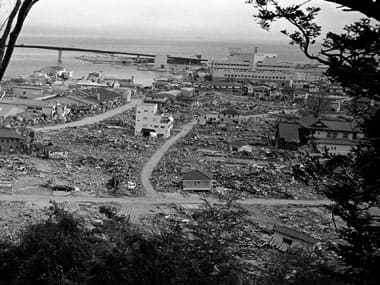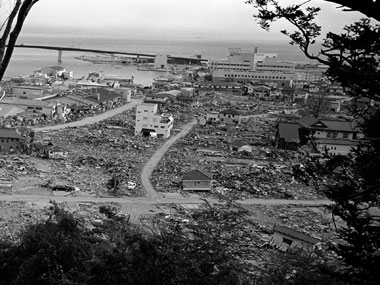Tokyo: A team of experts from the International Atomic Energy Agency has praised Japan for the steps it has taken to reduce radiation exposure near the crippled Fukushima Dai-ichi nuclear plant. During a nine-day trip, the IAEA team visited schools, farms and government offices outside the 12-kilometer exclusion zone surrounding the power plant, which was damaged by the March 11 earthquake and tsunami. In a preliminary report submitted to the government, the 12-member team said Japan had developed “an efficient program for remediation — allocating the necessary legal, financial and technological resources to bring relief to the people affected by the accident, with priority being given to children.” [caption id=“attachment_108848” align=“alignleft” width=“380” caption=“The devastation in Fukushima immediately following the earthquake and tsunami - Reuters”]
 [/caption]The report noted efforts to decontaminate schools and some 400 playgrounds — mostly by volunteers, many of them parents of students. Towns around the exclusion zone have begun washing down public areas and removing topsoil in parks and school yards. It was the U.N. atomic agency’s second major mission to Japan since the nuclear crisis. Its purpose was to assess Japan’s strategy and plans to reduce radiation exposure in areas around Fukushima prefecture. No one has died from radiation in the nuclear crisis, but concerns remain over how the lingering contamination will affect Fukushima’s youth. On Sunday, local doctors began a long-term survey of children in the region for thyroid abnormalities, a problem linked with radiation exposure. In Ukraine, more than 6,000 cases of thyroid cancer have been detected in people who were children or adolescents when they were exposed to high levels of fallout immediately after the 1986 Chernobyl nuclear disaster. Japan’s nuclear safety agency has said the radiation that leaked from the Fukushima plant was about one-sixth of that released from Chernobyl. Tero Tapio Varjoranta, deputy chief of the IAEA team, told a news conference in Tokyo that many of the Chernobyl cancer cases came from drinking milk that contained radioactive cesium, but said that Japan’s food control in this area were in “very good order.” The IAEA has “done a lot of work to learn the lessons from Chernobyl,” he said. The report also urged Japanese authorities to help the public focus on dose levels — the amount of radiation an individual is exposed to — rather than the contamination of certain areas or objects that could be far from the closest humans. “Contamination means radioactivity somewhere. Dosage is how it affects me,” Varjoranta explained. The team found Japan’s radiation monitoring system was “very good, very extensive,” said leader Juan Carlos Lentijo, adding that it would detect any dangerous spike in radiation. The Fukushima accident forced about 100,000 people living around the plant to be evacuated, and many now live in temporary homes or shelters, uncertain of when they will be able to return to their homes. Some Japanese officials say it could be years. Associated Press
[/caption]The report noted efforts to decontaminate schools and some 400 playgrounds — mostly by volunteers, many of them parents of students. Towns around the exclusion zone have begun washing down public areas and removing topsoil in parks and school yards. It was the U.N. atomic agency’s second major mission to Japan since the nuclear crisis. Its purpose was to assess Japan’s strategy and plans to reduce radiation exposure in areas around Fukushima prefecture. No one has died from radiation in the nuclear crisis, but concerns remain over how the lingering contamination will affect Fukushima’s youth. On Sunday, local doctors began a long-term survey of children in the region for thyroid abnormalities, a problem linked with radiation exposure. In Ukraine, more than 6,000 cases of thyroid cancer have been detected in people who were children or adolescents when they were exposed to high levels of fallout immediately after the 1986 Chernobyl nuclear disaster. Japan’s nuclear safety agency has said the radiation that leaked from the Fukushima plant was about one-sixth of that released from Chernobyl. Tero Tapio Varjoranta, deputy chief of the IAEA team, told a news conference in Tokyo that many of the Chernobyl cancer cases came from drinking milk that contained radioactive cesium, but said that Japan’s food control in this area were in “very good order.” The IAEA has “done a lot of work to learn the lessons from Chernobyl,” he said. The report also urged Japanese authorities to help the public focus on dose levels — the amount of radiation an individual is exposed to — rather than the contamination of certain areas or objects that could be far from the closest humans. “Contamination means radioactivity somewhere. Dosage is how it affects me,” Varjoranta explained. The team found Japan’s radiation monitoring system was “very good, very extensive,” said leader Juan Carlos Lentijo, adding that it would detect any dangerous spike in radiation. The Fukushima accident forced about 100,000 people living around the plant to be evacuated, and many now live in temporary homes or shelters, uncertain of when they will be able to return to their homes. Some Japanese officials say it could be years. Associated Press
Japan praised for post nuclear measures in Fukushima
FP Archives
• October 16, 2011, 09:29:51 IST
A team from the International Atomic Energy Agency has said that Japanese efforts to contain radiation exposure in and around Fukushima have been exemplary thus far.
Advertisement
)